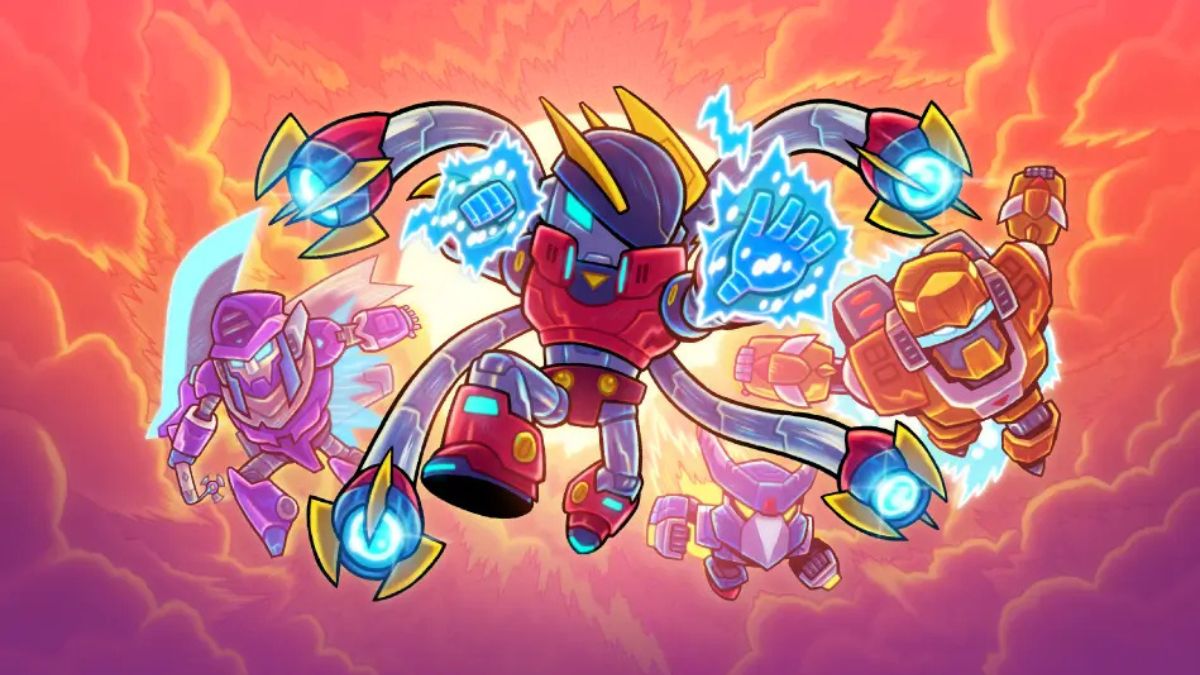Archives
Brawl Stars tier list: Ranking the most popular brawlers

Just because a brawler is popular doesn’t mean they’re the best!
 Brawl Stars remains one of the most competitive and fast-paced multiplayer mobile games on the market, and 2025 has brought some big shifts to the game’s meta. New balance patches, gadget tweaks, and a continually expanding roster have reshaped how players view certain brawlers. In this article, we’ll rank some of the most popular and frequently played brawlers across various game modes, based on performance, pick rates, and versatility.
Brawl Stars remains one of the most competitive and fast-paced multiplayer mobile games on the market, and 2025 has brought some big shifts to the game’s meta. New balance patches, gadget tweaks, and a continually expanding roster have reshaped how players view certain brawlers. In this article, we’ll rank some of the most popular and frequently played brawlers across various game modes, based on performance, pick rates, and versatility.
If you want to try out the best brawlers in the game as soon as possible, consider purchasing Brawl Stars accounts. This way, you can skip most — if not all — of the grind and play with your fully leveled brawlers!
S-Tier – The meta definers
Cordelius
Cordelius remains at the top of competitive and casual tier lists for good reason. His ability to isolate and punish individual targets using his Shadow Realm mechanic is unmatched. He not only wins 1v1 fights but also has strong presence in group engagements. He’s a great pick for players who enjoy fast-paced aggression and punishing squishy backliners.
Cordelius has incredible flexibility and fits into a wide range of team comps. His release initially raised questions about balance, and though he’s received some tuning since, he still reigns as one of the most powerful brawlers in the current pool.
Fang
Fang’s dominance comes from his ability to close gaps and punish clustered teams. His Super chains are devastating, and once he gets going, it can feel impossible to stop him. In team modes, Fang disrupts formations and often forces players to space out, breaking their synergy.
Though Fang is slightly harder to master due to the need for good timing and map awareness, his skill ceiling makes him a favorite in high-level play. If played well, he can single-handedly carry fights.
Poco (in a team with 2 tanks)
While Poco may seem simple on the surface, his synergy with tanky brawlers like Sam or Bull makes him part of one of the most durable team comps in the game. When used alongside a coordinated group, Poco becomes the lifeline that keeps aggressive pushes going non-stop.
His healing output, wide attack spread, and ability to control mid make him a support character that can still hold his own. He thrives especially in lower ranks and club league matches, where random matchmaking leads to more chaotic team fights.
A-Tier – Strong and reliable picks
Chester
Chester’s unique mechanic of having a random Super made him an unusual pick early on, but as players adapted, he rose in popularity. His unpredictability works both as a strength and a challenge for opponents trying to counter him.
Whether it’s healing, stun, or pure damage, Chester often finds a way to stay useful in any match. He doesn’t rely on any one mode or comp and instead slots into most team compositions with ease. His versatility keeps him consistently high in usage stats.
Buster
Once the terror of Brawl Ball queues, Buster has settled into a more balanced, but still powerful, position in the meta. His projector shield can protect entire teams from ranged attacks, and he’s excellent at pushing through tight choke points.
Buster rewards players who understand positioning and timing. He works well with coordinated teams but can also hold his own in solo queues. While he’s not as dominant as he was post-launch, he’s still among the best frontline brawlers.
Maisie
Maisie is a flexible mid-range brawler with solid crowd control and damage. Her ability to manipulate the battlefield with knockbacks and interrupts makes her particularly good in tight, high-pressure situations.
Maisie is most effective in hands that can predict enemy movement and apply consistent pressure. She’s an up and comer in the competitive scene thanks to her strong lane control and utility. Though she’s not flashy, she’s very efficient!

Shelly
Despite being the starter brawler, Shelly has made a surprising return to the meta. When played correctly— especially on maps with lots of bushes to hide in —she can dominate entire matches. Her Super can completely turn the tide in close-quarters battles.
Shelly has a reputation for being a beginner pick, but skilled players who use her gadgets and bush control strategically often find great success. She’s proof that even legacy brawlers can shine with the right strategy and environment.
B-Tier – capable but situational
Colt
Colt is a high-risk, high-reward brawler who relies heavily on precision. When played with accuracy, he delivers some of the highest sustained damage in the game. However, his narrow shot pattern and lack of mobility make him vulnerable.
In the hands of experienced players, Colt can be a real game-changer! But he’s far more map- and skill-dependent than other popular brawlers, which places him just below the top tiers.
El Primo
El Primo’s brute force and simple mechanics make him a popular pick, especially in casual games and showdown modes. His Super creates chaos, and he thrives when paired with supportive brawlers who can keep him alive long enough to get into the enemy backline.
Although he’s often countered by ranged brawlers, Primo remains a favorite in maps that allow for surprise ambushes and close encounters. His crowd-control potential is still respectable when the matchup is right.
Bea
Bea is a control-focused sniper with excellent range and zoning potential. Her charged shot mechanic allows her to deal enormous damage if she lands her shots, and her gadgets provide valuable crowd control.
While not as beginner-friendly due to her reliance on shot accuracy, Bea continues to be a solid pick in organized teams and long-range engagements. She’s particularly effective when anchoring a lane or holding key areas on open maps.
C-Tier — Picks with specific uses for experienced players
Edgar
Edgar is flashy, fast, and fun—but also fragile. He’s incredibly popular among new players due to his mobility and self-healing, but he struggles to maintain relevance in competitive modes.
He can be pretty useful in Showdown, but in 3v3 scenarios, Edgar often ends up feeding enemy Supers if misused. Still, players who invest in mastering his hit-and-run playstyle can make him work in specific situations.
Mortis
Mortis is a cult favorite and easily one of the hardest brawlers to master. His dash-based attacks and unique mechanics make him both stylish and frustrating. He’s an assassin who needs to pick the perfect moment to engage or risk being instantly punished.
In capable hands, Mortis can take over a game, especially when targeting weak brawlers in the backline. But his weaknesses in direct fights and difficulty scaling with team comps make him a tough sell for the average player.
Nita
Nita has fallen off in terms of raw power, but she still sees play due to her straightforward mechanics and ability to pressure with her bear. She’s particularly good in early leagues or with support brawlers who can keep her in the fight.
While newer brawlers have more tools and flexibility, Nita remains a viable option for players who know how to apply pressure and use her Super strategically. If you’re having trouble with this Brawler, make sure to check some of the many guides for this character that will help you get a better grasp on how to play her.
Image generated with ChatGPT
In conclusion
Brawl Stars continues to evolve with every update, and while tier lists will always shift, many of these brawlers are likely to remain dominant for the foreseeable future. Whether you’re trying to climb the Power League or just crush some solo Showdowns, understanding the current top picks and how to maximize their value can give you the edge you need.
Pick wisely, practice often, and don’t be afraid to try new combinations. Even a mid-tier brawler can become a game-winner with the right mindset and strategy!
Archives
Hentquz: The Cultural Impact and Evolution of a Niche Genre

Hentquz is more than just a niche genre; it’s a cultural phenomenon that has sparked conversations and debates across various platforms. With its unique blend of storytelling, artistry, and sometimes controversial themes, it has captured the attention of audiences far beyond its initial confines. As we delve into the world of hentquz, you’ll discover its intriguing origins and how it has evolved over time. From underground communities to mainstream recognition, this genre’s journey is nothing short of fascinating. Join us as we explore what makes hentquz a remarkable force in today’s entertainment landscape.
The Origins and History of Hentquz
Hentquz emerged from a blend of various cultural influences, primarily rooted in underground art forms. Its inception can be traced back to the early 2000s when digital platforms began fostering niche communities.
The genre gained traction through online forums and smaller publications. Artists sought to push boundaries, exploring themes seldom discussed in mainstream media. This experimental spirit attracted a dedicated following.
As it evolved, Hentquz incorporated elements from graphic novels and independent films. The fusion of visual storytelling with provocative narratives appealed to those craving authenticity.
Over time, conventions and exhibitions started showcasing this unique genre, further amplifying its presence within artistic circles. Hentquz became more than just an underground movement; it signified a shift towards embracing diverse perspectives in creative expression.
The Cultural Impact of Hentquz
Hentquz has carved out a distinct niche in pop culture. Its unique blend of storytelling and visual aesthetics captivates audiences worldwide. This genre often pushes boundaries, challenging societal norms and conventions.
The art style is influential, merging traditional techniques with modern digital artistry. Fans appreciate its innovative approach to character design and world-building. Moreover, it fosters community engagement through fan art and discussion forums.
Hentquz also sparks conversations about sexuality and identity. It allows for exploration of themes that mainstream media often shies away from. This connection resonates deeply with fans seeking representation.
Through social media platforms, Hentquz continues to gain traction across diverse demographics. The genre cultivates an inclusive environment where individuals can express their interests freely without judgment or stigma.
The Evolution of Hentquz: From Niche to Mainstream
Hentquz began as a small, niche genre, embraced by those who sought unique storytelling combined with artistic expression. Initially, it thrived in underground communities. Fans cherished the distinct aesthetics and unconventional themes that set it apart from more mainstream offerings.
Over time, social media platforms played a crucial role in its growth. Artists shared their work widely, attracting new audiences drawn to its boldness.
As acceptance of diverse genres increased globally, cultural barriers started to dissolve. Hentquz found itself featured at conventions and art exhibitions, gaining recognition beyond its original fanbase.
Today’s digital landscape has further propelled hentquz into the spotlight. Streaming services have begun to showcase this unique genre alongside other popular forms of entertainment. It’s no longer just an underground phenomenon; it’s becoming part of mainstream conversations around art and culture.
Criticisms and Controversies Surrounding Hentquz
Hentquz has faced its share of criticisms, sparking debates in various circles. Critics often cite the genre’s explicit content as a primary concern. They argue that it may perpetuate unrealistic expectations and unhealthy portrayals of relationships.
Another major point of contention stems from issues related to consent and representation. Some believe that certain narratives within hentquz can reinforce harmful stereotypes or objectify characters.
The community surrounding hentquz is also divided on how to address these concerns. While some creators strive for more responsible storytelling, others maintain the importance of artistic freedom. This tension highlights differing attitudes toward responsibility in creative expression.
Additionally, mainstream acceptance brings scrutiny from outside observers who question whether such genres should be normalized within broader culture. As the conversation continues, it’s clear that hentquz remains a topic ripe for discussion and debate.
Future Possibilities and Trends for Hentquz
The future of hentquz looks vibrant and full of potential. As technology advances, the boundaries of storytelling expand. Virtual reality experiences are likely to emerge, offering immersive worlds that allow fans to engage with characters like never before.
Increased collaboration between creators can lead to more diverse narratives. This could introduce fresh perspectives that resonate with broader audiences while still honoring traditional elements.
Social media platforms may also play a pivotal role in shaping trends within the genre. Short-form content and interactive formats will encourage fan participation, fostering community-driven creations.
Moreover, as acceptance grows, mainstream collaborations could become commonplace. Major artists might embrace hentquz themes in their work or merge genres for innovative projects.
With evolving societal norms and artistic expressions, surprises await those willing to explore this niche further. The journey ahead promises creativity and growth unlike any we’ve seen before.
Conclusion: Why Hentquz is Here to Stay
The realm of hentquz is undeniably fascinating. Its unique blend of storytelling and artistic expression resonates with a variety of audiences, pulling them into its vibrant world. As the genre continues to evolve, it embraces new influences while remaining true to its roots.
Hentquz has carved out a significant niche that reflects cultural shifts and societal changes. With technology advancing rapidly, creators are exploring innovative ways to engage their audience. This genre is not simply passing through; it’s establishing itself firmly in the fabric of modern culture.
As discussions around hentquz grow louder, so does the potential for further acceptance and understanding across demographics. It persists as an avenue for both artists and consumers who seek connection through shared experiences—whether humorous or heartfelt.
There’s no denying that as long as there’s creativity fueled by passion, hentquz will thrive. The future holds exciting possibilities for expansion, collaboration, and exploration within this unique art form. It’s clear: hentquz has found its place in our cultural landscape—and it’s likely here to stay.
Archives
Bardoek: Crafting Traditional Flavors with a Modern Twist

Bardoek is more than just a restaurant; it’s a culinary journey that bridges the gap between age-old traditions and contemporary dining. Imagine savoring flavors that have been passed down through generations, yet presented in a way that’s both fresh and exciting. This unique establishment invites you to experience the heart of traditional cuisine while showcasing modern techniques that elevate each dish to new heights.
At Bardoek, every meal tells a story—a narrative woven with rich cultural heritage and innovative creativity. Whether you’re an adventurous foodie or someone who cherishes comfort food, there’s something on the menu for everyone. Join us as we delve deeper into what makes Bardoek truly special, from its inspiration to its standout offerings. Your taste buds are in for quite the adventure!
The Inspiration Behind Bardoek’s Traditional Flavors
Bardoek draws its culinary inspiration from the rich tapestry of cultural traditions. The founders traveled extensively, tasting and absorbing flavors from various regions. Each dish tells a story steeped in history.
Local ingredients play a pivotal role in their offerings. Seasonal produce shines through, enhancing authenticity while supporting nearby farmers. This connection to the land fosters appreciation for regional fare.
Family recipes passed down generations influence Bardoek’s menu too. Chefs meticulously recreate these cherished dishes, infusing them with personal touches that honor their origins.
Every plate serves as a tribute to traditional cooking methods yet embraces innovation effortlessly. The result is an unforgettable dining experience that feels both nostalgic and fresh, inviting guests to explore familiar tastes in exciting new ways.
How Bardoek Incorporates Modern Techniques into Traditional Dishes
At Bardoek, tradition meets innovation in every dish. The chefs expertly blend age-old recipes with cutting-edge culinary techniques. This fusion creates flavors that are both familiar and surprising.
Sous-vide cooking is a prime example of this approach. By precisely controlling temperature, the meat retains moisture and flavor while achieving tender perfection. Traditional stews benefit from this method too, allowing spices to meld beautifully over time.
Fermentation plays another key role in elevating classic dishes. Fermented components add depth and umami, transforming simple ingredients into complex taste experiences.
Presentation also receives a modern touch at Bardoek. Dishes are plated artfully, turning meals into visual masterpieces that entice the senses before the first bite occurs.
Each menu item reflects meticulous attention to detail—balancing heritage with creativity for an unforgettable dining experience where old-world charm dances alongside contemporary flair.
Unique Menu Offerings at Bardoek
Bardoek’s menu is a delightful journey through flavors. Each dish tells a story, blending traditional recipes with contemporary flair.
One standout offering is the Heritage Lamb Tagine. Slow-cooked and infused with North African spices, it honors age-old techniques while appealing to modern palates.
Another must-try is the Culinary Fusion Risotto, featuring locally sourced vegetables and an unexpected twist of saffron oil. It reflects Bardoek’s commitment to sustainability without sacrificing taste.
For those craving something sweet, the Cardamom-infused Baklava provides a unique dessert experience. Layers of flaky pastry dance with rich honey and nuts for an indulgent finish.
Vegetarians will find joy in the Spiced Cauliflower Steak, grilled to perfection and served atop a bed of fragrant couscous. Each bite bursts with flavor while celebrating seasonal produce.
At Bardoek, every menu item invites guests to explore culinary traditions reimagined for today’s dining enthusiasts.
Customer Reviews and Experiences at Bardoek
Customers rave about their experiences at Bardoek. Many describe the atmosphere as inviting, with a blend of tradition and modernity that sets the perfect backdrop for a memorable meal.
Diners frequently mention the attentive service, noting how staff members go above and beyond to make every visit special. This personal touch enhances the dining experience significantly.
The food itself is often highlighted in reviews. Guests are enamored by how traditional flavors shine through in each dish while being presented with a contemporary flair.
Some patrons share stories of enjoying family celebrations or intimate dinners, creating lasting memories tied to Bardoek’s unique offerings. The fusion of tastes sparks conversations, making it not just a meal but an event worth sharing.
Customer feedback reflects genuine satisfaction with both the culinary delights and warm ambiance that define Bardoek’s charm.
The Team Behind Bardoek’s Success
At the heart of Bardoek lies a passionate team dedicated to culinary excellence. Each member brings unique skills and experiences, creating a dynamic atmosphere that thrives on creativity.
The chefs are the stars of the show. They blend traditional recipes with innovative techniques, ensuring every dish tells a story. Their commitment to quality ingredients shines through in every bite.
Front-of-house staff play an equally important role. With their warm smiles and attentiveness, they create an inviting environment for guests. They understand the menu deeply, ready to recommend pairings that elevate your dining experience.
Behind the scenes, management ensures smooth operations while fostering a culture of collaboration and continuous improvement. This teamwork allows Bardoek to adapt quickly while maintaining its core values.
Every individual contributes to making Bardoek what it is today—a place where tradition meets modernity on every plate served.
Conclusion: Why You Need to Try Bardoek for Yourself
Bardoek is more than just a dining destination. It’s an experience steeped in tradition yet vibrantly modern. The fusion of classic flavors with innovative techniques creates dishes that tell a story—one where the past meets the present in every bite.
With unique menu offerings that cater to diverse palates, there’s something for everyone at Bardoek. Whether you’re drawn by the rich heritage or curious about how traditional recipes can be reimagined, your taste buds are in for a treat.
Customer reviews highlight not only the delightful food but also the warm atmosphere and attentive service. This makes each visit special and memorable, inviting guests to return again and again.
Behind this culinary gem is a passionate team dedicated to honoring tradition while embracing creativity. Their commitment shines through every dish they serve.
If you’re looking for an adventure for your palate or simply want to enjoy comforting flavors made fresh with flair, Bardoek awaits you! Don’t miss out on experiencing its charm firsthand—you might just discover your new favorite spot.
Archives
Hormita: Preserving Paradise for Future Generations

Nestled in the heart of untouched nature, Hormita is a hidden gem waiting to be explored. This stunning locale is not just about breathtaking views and serene landscapes; it embodies a rich tapestry of culture and biodiversity that deserves our utmost attention. As we venture into this paradise, its significance becomes crystal clear—it’s more than just a destination; it’s a vital ecosystem that plays an essential role in maintaining environmental balance.
However, with beauty comes vulnerability. The delicate equilibrium of Hormita faces numerous challenges as both local communities and visitors grapple with the responsibility of preserving this natural wonder. Let’s delve deeper into what makes Hormita so special, the hurdles it currently faces, and how efforts are underway to safeguard its future for generations to come.
Challenges facing the preservation of Hormita
Hormita faces numerous challenges in its quest for preservation. Rapid urban development poses a significant threat. As more people flock to this paradise, construction projects disrupt the delicate balance of its ecosystems.
Pollution from increased tourism also jeopardizes Hormita’s pristine environment. Waste management remains an ongoing concern as visitors often overlook responsible practices.
Natural disasters further complicate preservation efforts. Hurricanes and rising sea levels can erode coastal areas, leading to habitat loss for local wildlife.
Additionally, the lack of awareness among tourists about sustainable practices puts pressure on natural resources. This lack of education can lead to behaviors that harm both land and marine life.
Balancing economic growth with environmental conservation continues to be a daunting task for those committed to protecting Hormita’s beauty and biodiversity.
Efforts made by locals and organizations to protect Hormita
Locals in Hormita are rallying together, fueled by a deep love for their land. They organize clean-up drives to remove debris from the beaches and restore habitats. These community-led initiatives help raise awareness about the importance of maintaining a pristine environment.
Organizations dedicated to conservation have also stepped in. They provide resources and training for sustainable practices that benefit both the ecosystem and local families. Workshops on eco-friendly farming techniques enable residents to thrive without harming nature.
Collaborations with educational institutions promote environmental education among youth. Schools incorporate lessons about biodiversity, instilling respect for Hormita’s unique ecosystems early on.
Additionally, partnerships with global NGOs bring attention and funding necessary for larger preservation projects. Together, these efforts showcase a unified commitment to protecting Hormita’s natural beauty while fostering community pride and resilience against outside threats.
The impact of tourism on Hormita’s environment
Tourism brings both benefits and challenges to Hormita. As visitors flock to its pristine beaches and lush landscapes, the natural environment faces significant strain. Increased foot traffic can lead to soil erosion, damaging delicate ecosystems.
The influx of tourists often means more waste. Local wildlife struggles with litter that disrupts their habitat. Marine life is particularly vulnerable as plastic pollution finds its way into the ocean.
Moreover, water resources become strained during peak seasons when demand skyrockets. This raises concerns about sustainability for both locals and nature alike.
Yet tourism also has the potential to raise awareness about environmental issues in Hormita. Educated travelers can champion conservation efforts and support local initiatives aimed at preserving this beautiful paradise for years to come. The challenge lies in balancing visitor enjoyment with ecological preservation, ensuring that future generations can experience Hormita’s wonders just as they are today.
Sustainable tourism practices in Hormita
Sustainable tourism practices in Hormita are essential for maintaining its natural beauty and ecological balance. Tourists are encouraged to respect local wildlife and habitats. Simple actions like staying on designated trails can make a big difference.
Local businesses promote eco-friendly accommodations, using renewable energy sources and minimizing waste. Many establishments focus on sourcing food locally, which supports the community while reducing carbon footprints.
Educational programs help visitors understand the region’s unique ecosystems. Guided tours led by knowledgeable locals provide insights into preserving this paradise. Travelers leave with a deeper appreciation of nature’s wonders.
Community initiatives also play a vital role in sustainable tourism efforts, showcasing traditional crafts and cultural heritage. This fosters an authentic experience while ensuring that local customs thrive amidst modernity.
By embracing these practices, Hormita sets an example of how tourism can coexist harmoniously with nature, ensuring future generations enjoy this stunning environment as much as we do today.
Future plans and developments for preserving Hormita
Future plans for preserving Hormita are ambitious and community-driven. Local organizations, along with environmentalists, are developing initiatives to enhance conservation efforts. These projects aim to protect the unique biodiversity found in this paradise.
One of the key developments includes creating designated protected areas. This will help safeguard fragile ecosystems from human encroachment. Education programs are also being implemented to raise awareness among residents and visitors alike about the importance of preservation.
Sustainable infrastructure projects are on the horizon as well. Eco-friendly accommodations and facilities will minimize impact while promoting responsible tourism practices.
Collaboration between government bodies and local communities is essential for success. Engaging stakeholders ensures that everyone has a voice in shaping Hormita’s future, making it a true model for sustainable living.
Innovative strategies like habitat restoration will be prioritized, focusing on reintroducing native species and rehabilitating damaged landscapes over time.
Conclusion: Why it is important to preserve Hormita for future generations
Preserving Hormita is essential for various reasons. This unique ecosystem is not just a beautiful destination; it holds immense ecological value. By safeguarding its natural resources, we ensure that future generations can experience the vibrant flora and fauna that make Hormita special.
Moreover, protecting Hormita means maintaining the cultural heritage of local communities. For many residents, their identity is intertwined with the land they inhabit. Their traditions and lifestyles depend on a healthy environment.
Sustainable tourism practices play a critical role in this preservation effort. They create economic opportunities while minimizing environmental impact, allowing both nature and local culture to thrive alongside visitors.
As stewards of our planet, prioritizing efforts to preserve Hormita ensures that its beauty endures for years to come. The actions we take today can safeguard this paradise, making it accessible and enjoyable for generations yet unborn. It’s our responsibility to act now so that future travelers can revel in everything Hormita has to offer—untouched landscapes, rich biodiversity, and an authentic connection with nature.
-

 Cast7 months ago
Cast7 months agoRico Rodriguez
-

 Episode Guide7 months ago
Episode Guide7 months agoHalloween episodes
-

 Cast7 months ago
Cast7 months agoCast
-

 Guest Star7 months ago
Guest Star7 months agoValentine’s Day episodes
-

 Cast7 months ago
Cast7 months agoWho is your favourite character?
-

 Guest Star7 months ago
Guest Star7 months agoGuest Star: Khamani Griffin
-

 Cast7 months ago
Cast7 months agoSarah Hyland
-

 Episode Guide7 months ago
Episode Guide7 months agoEpisode Guide : Season 1
